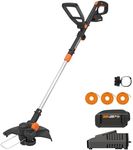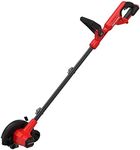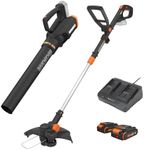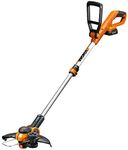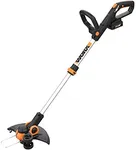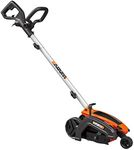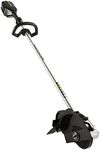Buying Guide for the Best Lawn Edgers
Choosing the right lawn edger can make a big difference in how neat and tidy your yard looks. Lawn edgers are designed to create clean, defined lines along sidewalks, driveways, and garden beds, giving your lawn a professional appearance. When picking a lawn edger, it's important to think about the size of your yard, the type of edges you want to create, and how much effort you're willing to put into maintenance and operation. Understanding the key features will help you select an edger that matches your needs and makes the job easier and more effective.Power SourceThe power source refers to how the lawn edger is powered—either by gas, electricity (corded), or battery (cordless). Gas-powered edgers are usually more powerful and suitable for large or tough jobs, but they are heavier, noisier, and require more maintenance. Corded electric edgers are lighter and quieter, but you need to be near an outlet and manage the cord. Battery-powered edgers offer more mobility and are quieter, but their run time is limited by battery life. To choose the right one, consider the size of your yard and how much power you need. For small to medium yards with easy access to power, electric or battery models are often sufficient. For larger areas or tougher grass and soil, gas might be better.
Blade Type and AdjustabilityThe blade is the part that actually cuts the edge, and its type and adjustability affect how well the edger works on different surfaces. Some edgers have single blades, while others have dual or star-shaped blades for more aggressive cutting. Adjustable blades let you change the depth and angle of the cut, which is useful for different edging styles or ground conditions. If you want crisp, deep edges or need to handle uneven terrain, look for an edger with adjustable blade settings. For simple, straight edges on flat ground, a basic fixed blade may be enough.
Cutting DepthCutting depth is how deep the blade can go into the ground. This is important because deeper cuts create more defined edges and can help prevent grass from spreading into unwanted areas. Cutting depths usually range from about half an inch to two inches or more. If you want a very sharp, professional look or need to edge along thick grass or roots, choose an edger with a greater maximum cutting depth. For light maintenance or shallow edges, a smaller depth will do.
Weight and ManeuverabilityWeight and maneuverability refer to how heavy the edger is and how easy it is to move around. Heavier edgers can be harder to push, especially over long distances or uneven ground, but they may offer more stability. Lighter models are easier to handle and better for people who may not want to deal with a bulky machine. If you have a lot of curves or tight spaces in your yard, look for a lightweight, easy-to-maneuver edger. For straight, long edges, a heavier model might be fine.
Handle Design and ComfortThe handle design affects how comfortable the edger is to use, especially for longer periods. Some handles are adjustable in height or angle, and some have padded grips to reduce hand fatigue. If you plan to use the edger often or for long sessions, look for ergonomic handles that can be adjusted to your height and have comfortable grips. This will make the job less tiring and help you maintain better control.
Maintenance RequirementsMaintenance requirements include how much care the edger needs to keep working well. Gas models need regular engine maintenance, oil changes, and fuel management. Electric and battery models are generally easier to maintain, needing only occasional blade sharpening and cleaning. If you prefer a low-maintenance tool, electric or battery-powered edgers are a good choice. If you don't mind a bit more upkeep for extra power, gas models are worth considering.


